Historical and Technical Documentation by Pamela Brooks,
Kelvin Hastie and John Maidment © OHTA (last updated June 2023)
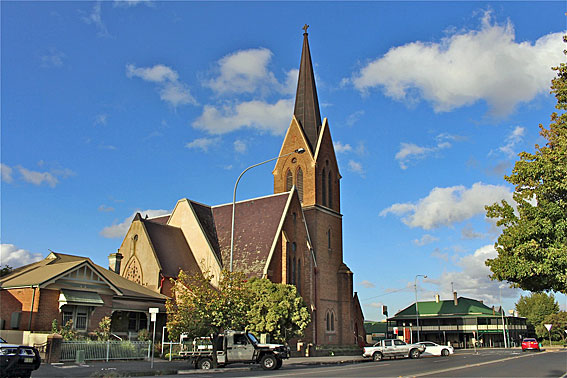
Holy Trinity Anglican Church, Orange: exterior
[photograph by Trevor Bunning (March 2019)]
Historical and Technical Documentation by Pamela Brooks,
Kelvin Hastie and John Maidment © OHTA (last updated June 2023)

Holy Trinity Anglican Church, Orange: exterior
[photograph by Trevor Bunning (March 2019)]
The designs of prominent Sydney architect Thomas Rowe FRIBA for the Church of England at Orange were announced in 1877.1 The building was to cost £4320, but excluding the spire, turrets and galleries. The building had a length of 107 feet and was built in a high Victorian Gothic style from brick with a tower and spire of Germanic inspiration and a lofty nave and transepts. The church was opened on 27 August 1879.2 The tower and spire were completed in 1925 as a war memorial and were designed by Sir Charles Rosenthal & Day, of Sydney, a simplified version of Rowe’s original design. It is not known what the first organ may have been. A full history of the organ at this church is contained in Sing Praise to the Lord! : the story of the pipe organ at Holy Trinity Anglican Church, Orange, its organists, choristers and music, written in 2013 by church organist Pamela Brooks. This provides an attractively-presented history of the organ, the organists and church music at Holy Trinity.
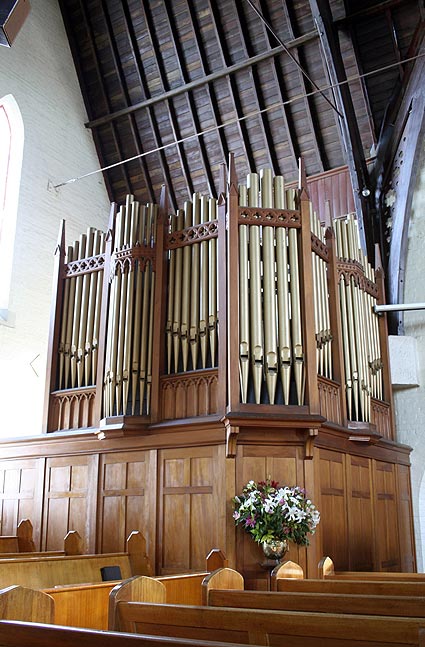
Holy Trinity Anglican Church, Orange: organ case
[photograph by Trevor Bunning (May 2006)]
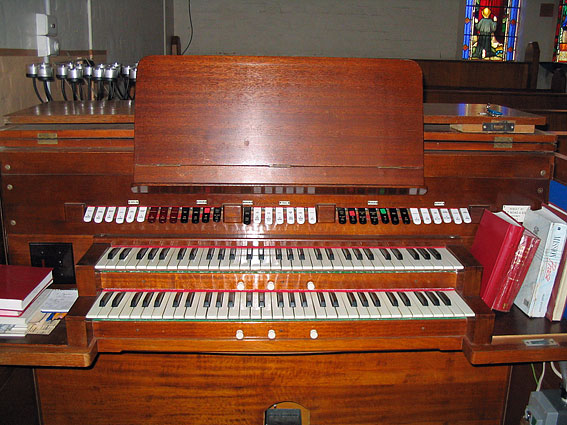
Holy Trinity Anglican Church, Orange: the Noad console
[photograph by Martin Adkins (September 2009)]
The present organ was completed in 1913 by Frederick Ernest (Friedrich Ernst) Ladegast (1853-1937), a German immigrant builder3 who worked under the name of the British Pianoforte Depot Ltd.4 (The organ at Christ Church, Kiama, built in 1914, is a rare example of an instrument built under his own name). Ladegast’s father was the noted German organ builder, Friedrich Ladegast, who built the famous organ at Merseburg Cathedral in 1855, for which Franz Liszt wrote several of his best-known works, including the Prelude and Fugue on B.A.C.H. and the Fantasy and Fugue on “Ad nos, ad salutarem undam”. As a result, the instruments of the British Pianoforte Depot Ltd all display some Germanic features, often seen in console design, chest construction and pipe forms. In spite of this, they all reflect British tonal design of the period and the preferences of local organists and consultants, in this case Mr C.A. Jarman, organist of All Saints’ Cathedral, Bathurst.
An account of the organ was published on 29 January 1913:
The New Organ at Orange.
A pipe organ has been installed in Holy Trinity Church, Orange and is one of the finest in the State. The church was crowded on January 23, when the Bishop of Bathurst (Dr. Long) dedicated the organ, and Mr. C. A. Jarman, organist of All Saints' Cathedral, Bathurst, gave a recital after the service. Mr. Jarman drew up the specifications for the organ, which consists of two manuals and pedal organ. The action is tubular pneumatic throughout, with the console extended a certain distance from the organ so as to bring the organist into touch with the choir, and within vision of the Sanctuary. The Swell Organ contains the following stops: Bourdon 16ft., Violin Diapason 8ft., Lieblich Gedact 8ft., Voix Celeste 8ft., Oboe 8ft., and Salicet 4ft., Octave Coupler. The Great Organ contains Open Diapason 8ft., Stopped Diapason 8ft., Dulciana 8ft., Principal 4ft., and Fifteenth 2ft. The Pedal Organ contains Bourdon. 16ft., and Major Bass 16ft. Couplers: Swell to Great, Great to Pedal and Swell to Pedal. Accessories: Three Pneumatic Pistons to each Swell and Great Organs, with patent release piston to each manual. Tremulant to Swell Organ, and Balanced Swell Pedal. The Pedal Board is according to the Royal College of Organists scale and is Radiating and Concave. All metal pipes were from the manufactory of Alfred Palmer and Sons, London, and the contract of building the organ was given to the British Piano Depot. The organ builder was Mr. E. Ladegast.5
The organ had a detached terraced drawstop console with the stop labels shown in various colours: Great – white, Swell – pink, Pedal – green.6
The organ survived in its original form until 1955 when S.T. Noad & Son secured a contract to rebuild and enlarge it, providing additional manual ranks in the form of a Great Hohl Flute 8ft, Swell Gamba 8ft and Cornopean 8ft and extensions of the existing pedal ranks to provide additional stops. The range of couplers was greatly increased. In 1966 the leather puffers under the ventil-style chests were replaced and damage by vandals was rectified by Roger H. Pogson in 1982, with further repairs made by him in 1984 and 1985. In 1987, the Noad console was moved. Storm damage led to yet further repairs by Pogson in 1993, at which time opportunity was taken to install a replacement Swell Cornopean 8ft and Gemshorn 4ft to displace an existing 4ft stop.7
A new console has been manufactured by Ian D. Brown & Associates, of Ballina, NSW and will be installed later in 2023.8 There will be small changes to the above specification including a Great Twelfth in place of the Noad Hohl Flute, and the Swell Harmonic Flute will be correctly relabelled Gemshorn. A reduced number of couplers will be provided.9
The specification as at June 2023 is:
| GREAT Open Diapason Stopped Diapason Hohl Flute Dulciana Principal Fifteenth |
8 8 8 8 4 2 |
||
| SWELL Bourdon Violin Diapason Lieblich Gedact Gamba Voix Celeste Harmonic Flute Cornopean Oboe Tremulant |
16 8 8 8 8 4 8 8 |
+ + |
|
| PEDAL Major Bass Sub Bass Quint Open Flute Bass Flute Octave |
16 16 12 8 8 4 |
A B B A B A |
|
| COUPLERS Swell Sub Swell Super Swell to Pedal Swell Octave to Pedal Pedal Super Great Octave to Pedal Great to Pedal Swell Super to Great Swell Sub to Great Swell to Great Great Super Great Sub10 |
+ Installed 1993 by Pogson using 1898 Charles Richardson pipework from St Enoch’s Presbyterian Church, Newtown. The “Harmonic Flute” is now a Gemshorn.
Electro-pneumatic action
Compass 61/30
Detached stopkey console
Balanced swell pedal, 3 pistons on each manual & 3 toe pistons
1 Town and Country Journal, 6 June 1877, p.21
2 Maitland Mercury, 28 August 1879, p.3
3 see Alexander Koschel, Im Wandel der Zeit Die Ladegasts und ihre Orgeln, (Weissenfelds: Fagott, 2004) for a complete history of the firm and its descendants.
4 See Graeme D.Rushworth, Historic Organs of New South Wales, (Sydney: Hale & Iremonger, 1988), pp. 151-156 for further details of his Australian career.
5 Australian Town and Country Journal, 29 January 1913, p.54
6 Graeme D. Rushworth, A Supplement to Historic Organs of New South Wales. (Camberwell, Vic.: Organ Historical Trust of Australia, 2006), p.38
7 Pamela Brooks, Sing Praise to the Lord! : the story of the pipe organ at Holy Trinity Anglican Church, Orange, its organists, choristers and music (Orange: G.K. Craig Pty Ltd, 2013), pp. 34, 40 and 46
8 Email from Ian Brown to Kelvin Hastie, 14 April 2023
9 Facebook posting from Ian Brown, accessed 9 June 2023
10 Specification confirmed in Facebook posting from Thomas Glastonbury, accessed 9 June 2023
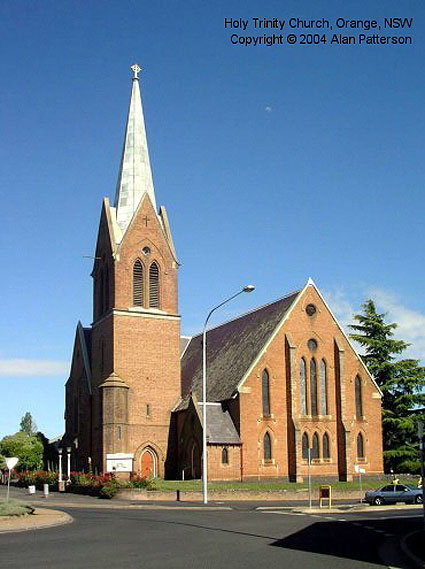
Holy Trinity Anglican Church, Orange: exterior
[photograph by Ian Patterson (2004)]
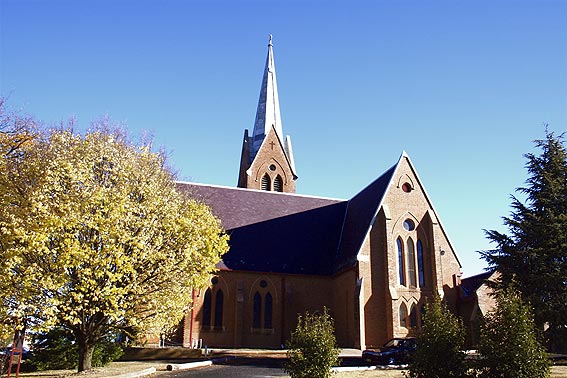
Holy Trinity Anglican Church, Orange: exterior
[photograph by Trevor Bunning (Mary 2006]